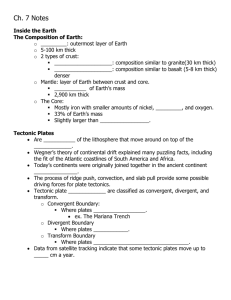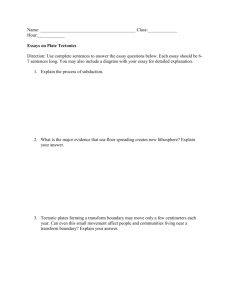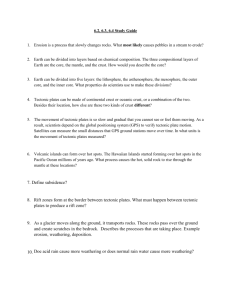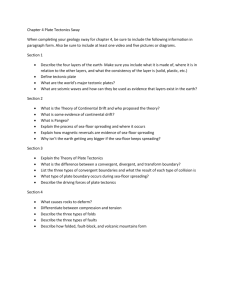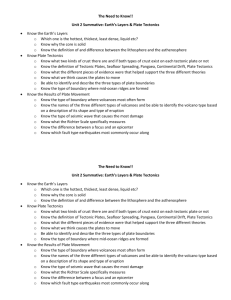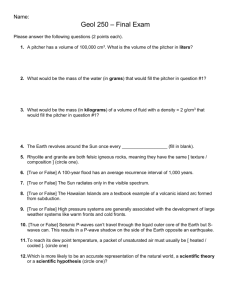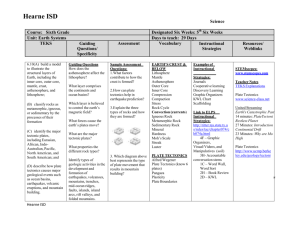Study Guide – Ch 7 Plate Tectonics Modified
advertisement
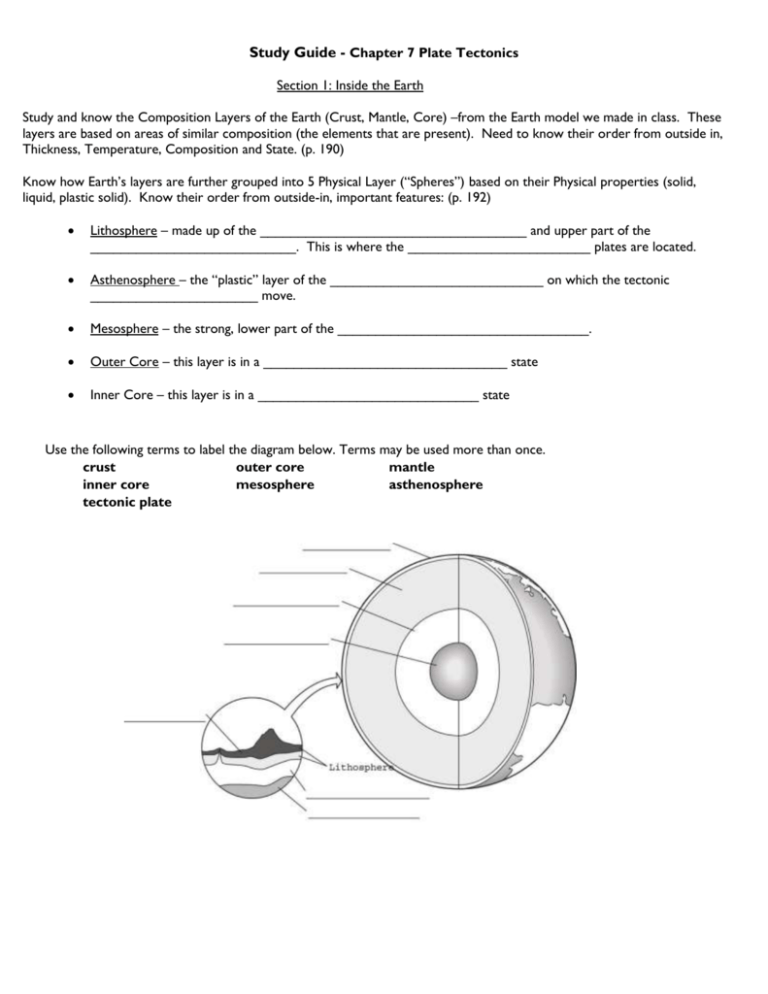
Study Guide - Chapter 7 Plate Tectonics Section 1: Inside the Earth Study and know the Composition Layers of the Earth (Crust, Mantle, Core) –from the Earth model we made in class. These layers are based on areas of similar composition (the elements that are present). Need to know their order from outside in, Thickness, Temperature, Composition and State. (p. 190) Know how Earth’s layers are further grouped into 5 Physical Layer (“Spheres”) based on their Physical properties (solid, liquid, plastic solid). Know their order from outside-in, important features: (p. 192) Lithosphere – made up of the ___________________________________ and upper part of the ___________________________. This is where the ________________________ plates are located. Asthenosphere – the “plastic” layer of the ____________________________ on which the tectonic ______________________ move. Mesosphere – the strong, lower part of the _________________________________. Outer Core – this layer is in a ________________________________ state Inner Core – this layer is in a _____________________________ state Use the following terms to label the diagram below. Terms may be used more than once. crust outer core mantle inner core mesosphere asthenosphere tectonic plate Study Guide - Chapter 7 Plate Tectonics Section 2: Restless Continents What is Continental Drift and who came up with the idea? (p. 198) Continental Drift is the ____________________ that states that the continents once formed a single ____________, broke up, and ____________________ to their present locations. A scientist named ________________________ came up with the theory in the early _______________. What is Pangea? (p. 199) Pangea was a ____________________________ formed when all the present continents were joined in one huge, single _____________________. We now know from the hypothesis of __________________________ that Pangea existed about _________________ million years ago. Use the two terms below to explain how we know the Continents/Tectonic Plates move: (p. 198, 205) Fossils GPS ____________________________ explains why fossils of the same plant and animal species are found on ______________ that are on different sides of the __________________ Ocean. Many ancient species could not have crossed the Atlantic Ocean. __________________ use a system of ________________ called the _____________________________________ (GPS), to measure the rate of ________________________ movement. Radio signals are continuously beamed from ________________ to GPS ground stations, which record the exact ______________________ between the satellites and ground station. Over time, these distances change ________________. By recording the time it takes for the GPS ground stations to move a given ____________, scientists can measure the _____________________ at which each __________________________ moves. What happens when plates separate on the sea floor and what evidence do we have that this takes place? (p. 200, 201) Mid-ocean ridges are places where ______________________________________ takes place. Sea-floor spreading is the process by which new _______________________________ forms as magma rises toward the _______________ and _________________. Some of the most important ___________________ of sea-floor spreading comes from magnetic ____________________ recorded in the ocean floor. Which is older rock, rock that is close to the mid-ocean ridge or rock that is far away from the mid-ocean ridge? ________________________________________________________________________________________ Section 3: The Theory of Plate Tectonics What does the theory of Plate Tectonics say? (p. 202) Plate Tectonics is the theory that the Earth’s ______________________ is divided into tectonic plates that move around on top of the __________________________. What might be the cause of the movement of tectonic plates? (p. 204) This movement occurs because of changes in ___________________ within the __________________________. These density changes are caused by the outward flow of thermal energy from deep within the ______________. When rock is heated, it expands, becomes less _______________, and tends to rise up to the _______________ of the ____________________. As the rock gets near the surface, the rock cools, becomes more dense and tends to Study Guide - Chapter 7 Plate Tectonics sink. This is called _______________. What do tectonic plates consist of? ______________________________________________________________________________________ Describe the types of Boundaries that exist between plates, what causes the boundaries and what the results are: (p. 203) Boundary Formed by Plates doing what? What is the Result? Convergent Divergent Transform Section 4: Deforming the Earth’s Crust What is stress? ____________________________________________________________________________ ________________________________________________________________________________________ What causes rocks to deform? (p. 206) ________________________________________________________________________________________ ________________________________________________________________________________________ _____________________________________________________________ What are the two possible results of deformation? (p. 206) ____________________________________ or _____________________________________ When rocks are SQUEEZED we call this ______________________________________________ (p. 206) When rocks are –STRETCHED- we call this __________________________________________ (p. 206) What is folding? (p. 207) ________________________________________________________________________________________ ________________________________________________________________________________________ Study Guide - Chapter 7 Plate Tectonics What is faulting? (p. 208) ________________________________________________________________________________________ ________________________________________________________________________________________ Know the different types of deformations, what the cause is and an example of this type of deformation: (p. 207-211): Type of Deformation Cause Example (fault)(fault)(fault)Fold Vocabulary Terms: Seismic wave - a vibration in rock that travels out from the focus of an earthquake in all directions; seismic waves can also be caused by explosions (GPS) global positioning system - a network of satellites that orbit the Earth to measure positions on the Earth's surface sea-floor spreading- the process by which new oceanic lithosphere (sea floor) forms as magma rises to Earth's surface and solidifies at a mid-ocean ridge Order of physical earth: Lithosphere, Asthenosphere, Mesosphere, Outer Core, Inner Core Gondwana - the southern landmass that supposedly fragmented millions of years ago to form South America, Africa, India, Australia, and Antarctica uplift- the rising of regions of the Earth's crust to higher elevations subsidence - the sinking of regions of the Earth's crust to lower elevations anticline (“ant hill”)- an arch-shaped fold in rock layers in which the oldest layer is in the center of the fold syncline (“sink hole”) - a downward fold of stratified rocks in which the sides slope downward toward each other


